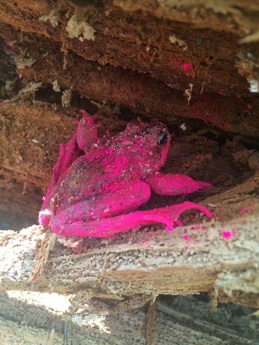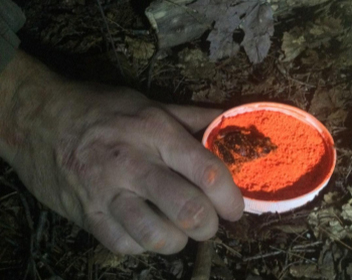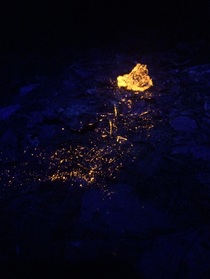Mitchell Jones, PhD student, University of Maine
Every spring wood frogs thaw out and migrate to vernal pools to breed. The males are the first to arrive to pools and begin the chorus. Perhaps less infamous than the impressively loud call of the spring peeper, the wood frog’s call is no less distinct. It is more of a bark and can sometimes be missed behind the chirps of the peepers. While their calling attracts mates it also attracts predators making vernal pools potentially dangerous places for adult wood frogs. On several of my visits I observed barred owls sitting directly above the pool and camera traps have captured images of raccoons and foxes among other animals.
The increased risk associated with being in and around pools drives wood frogs to leave them soon after the eggs are laid. One of the questions I am seeking to answer is; where do they go and how does human activity influence their movement? Previous work done in our lab shows amphibians avoid forest clear cuts and are less willing to move through grass, fields, and parking lots than an undisturbed forest floor. This has to do with relative humidity on the ground, because amphibians breathe through their skin they must stay moist to survive. Leaf litter on the forest floor provides a safe haven from drying out that a lawn and parking lot do not. This means the frogs likely wouldn’t ever settle in these areas but a major question is will they cross them to get to the place that they do want to spend the summer?
To answer the question “where do wood frogs go” we need to be able to follow them. This task is much easier said than done, most wood frogs are less than 2 inches long and extremely well camouflaged. They move at night often in the rain and following them with a flashlight would certainly alter their behavior. Using radio tags is a really good way to find out where frogs go but not necessarily the path they took to get there, which is what we wanted to know. To determine that path you need to track every step, the average adult wood frog weighs somewhere around 10 grams which is less than a tablespoon of sugar. Needless to say they don’t leave footprints. To get around this we use a fluorescent powder that coats their bodies and leaves tracks as they hop away.
 Using this powdering technique I was able to follow a total of 19 adult wood frogs leaving a vernal pool in Orono, Maine. These frogs would move around 20 yards the night they left the pools and hunker down for a night or two before moving again. They would hide in logs, stream banks, roots, tunnels and more often than not I would lose the trail as they slipped underground to find cover or forage. A fascinating observation was how straight the path of movement was for most of these frogs, they really seemed as if they knew where they were going.
Using this powdering technique I was able to follow a total of 19 adult wood frogs leaving a vernal pool in Orono, Maine. These frogs would move around 20 yards the night they left the pools and hunker down for a night or two before moving again. They would hide in logs, stream banks, roots, tunnels and more often than not I would lose the trail as they slipped underground to find cover or forage. A fascinating observation was how straight the path of movement was for most of these frogs, they really seemed as if they knew where they were going.
Perhaps the most interesting observation was about a frog whose movement I tracked for 6 nights. This frog beelined it straight in the direction of a lot that was recently clear cut for a house site. About 20 meters shy of the clear cut it stopped for 2 nights and then took a 90 degree turn and moved parallel to the clear cut in the forest for the next 3 nights until I lost his trail in a bog. I cannot say whether or not had the land not been clear cut that this individual would have kept going straight, but based on previous work done in our lab and the behavior of other frogs I observed I would venture to say that clear cut housing lot made that frog change course.


